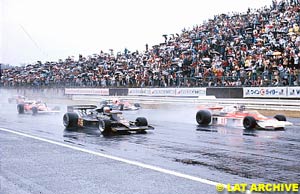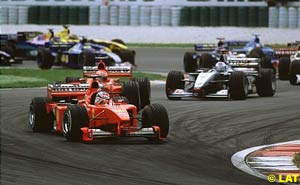
Atlas F1 Contributing Writer
Although relatively new to the Formula One World Championship, the Sepang circuit in Malaysia is by no means the first Asian motor racing venue. Journalist and historian Doug Nye looks back at the history of motor racing in Asia, and in Malaysia in particular
As you drift ever lower over the militarily-precise plantation palms, it's sometimes possible - if the wind's in the right direction - to glimpse from the approach flightpath to the bright and shiny newness of Malaysia's other 21st Century showpiece: the home of Round 2 of this year's Formula One World Championship, the Sepang circuit.
Widely accepted as having set entirely new motor racing circuit standards upon its inauguration on December 12th 1998, Sepang proudly displays every sign of having been built with a virtually open-ended budget - Malaysian Government support having encouraged an investment promoted as totalling no less than 120-million US Dollars.
Before the site was selected for this development, the original village of Sepang had been just another small and remote rural settlement - yet one still handily located barely 60 kilometres from Kuala Lumpur city, and only 15kms from the vast new expanse of Kuala Lumpur International Airport - whose cost of closer to 2.5-billion US Dollars puts the circuit investment squarely into perspective.
Sepang's Malaysian Grand Prix venue is linked to both KLIA airport and to the capital city itself - just 40 minutes' drive away - via another brand-spanking piece of modern infrastructure, a new dual-lane highway.
But for Asian racing enthusiasts in general - and for Malaysian enthusiasts in particular - Sepang is more than just another stop-off for the globe-trotting Formula One World Championship circus; it is an expression of both continental, and national pride - of an emergent high-tech nation which has been made welcome at the western world's established motor sporting table.
Re-wind through Asian motor sporting history and, not far back, one finds the first Asiatic round ever to be included in Formula One's World Championship, run on the Mt. Fuji Raceway, in Japan, in 1976. That extraordinary Japanese Grand Prix - held only 26 brief years ago - could hardly have been more dramatic.
The duel for the 1976 Drivers' World Championship had raged all year between Niki Lauda of Ferrari and James Hunt of McLaren. Technical infringements, disqualifications, reinstatements - all had been capped by Niki's near-fatal fiery accident during the German Grand Prix at the Nurburgring. He had then bounced back into contention after missing only two Grands Prix, but at Fuji the race start was delayed way towards dusk by torrential rain, and Niki opted out just after the start, leaving his and Ferrari's Championship hopes entirely dependent on whatever fate should deal out to James.
The lanky Englishman led, lost the place with a puncture, and had to fight back through the pack to finish at least third to take the title. He saw the chequered flag, thought the combination of fate and his team had blown it for him, and hammered back into the pits post-race, utterly incensed at his perceived failure and ready to take a swing at everybody.
But as he erupted from his steaming, sizzling car, McLaren team chief Teddy Mayer simply brandished three fingers at him, bawling "You finished third, you've won, you've won - you're World Champion!" Perhaps the now ageing air hostesses from the Tokyo flight still recall new World Champion Hunt's shenanigans from that long, frenetic celebratory night...
Mt Fuji Raceway had been the second Asian circuit to gain real international stature, after the Honda test and development course at Suzuka. That wonderful circuit - designed for Honda by John Hugenholtz of Zandvoort (Dutch Grand Prix) track-design fame - had been built during 1961-62 and hosted its first grandly titled 'International Grand Prix' for sports cars in 1963, totally dominated by British-entered Lotus 23s driven by Peter Warr - later head of Team Lotus - Bill Knight and Arthur Owen.
Over 100,000 fans had packed into Suzuka for that first great race, and after Formula One found its feet in Japan at Mt Fuji in 1976-77, it was revived at Suzuka ten years later, with the Aida course's Pacific Grands Prix later thrown in for good measure in 1994-95.
But wind back still further, and the tap roots of international motor sport in Asia penetrate deeper still. During the 1930s, Count Kobayakawa, behind the wheel of an imported British MG K3, and Soichiro Honda in his fearsome Curtiss aero-engined special were two of the stars of Tokyo's pre-war speedway racing on a track laid out on the flat gravel bars of a nearby riverbed.
For his 21st birthday, Chula bought cousin Bira a brand-new state-of-the-art ERA voiturette - for the schoolroom 'Formula 3000-equivalent' class of the period - and under the pseudonym 'B. Bira' the young Siamese became absolutely one of the finest and best-known British-based racing drivers of the period.
Chula ran a wonderfully well-organised and efficient team - they ended-up campaigning no fewer than three assorted ERAs, a Grand Prix Maserati and a Delage before the outbreak of war in 1939, and carried home a swag of significant racing trophies in both the UK and in continental Europe.
Chula and Bira were both keen to show their countrymen what international-level motor racing was all about, and they laid plans for a Bangkok Grand Prix to be run right in the Thai capital - only to be forestalled by the outbreak of the Second World War.
Postwar, the British colonial settlers in the Malay peninsula seem to have been particularly motoring minded, with those living, working, or based as military servicemen in Hong Kong and the adjacent Portuguese colony of Macau also developing motor sporting ambitions.
The Macau Grand Prix became a round-the-city road race whose tradition has survived to this day, while on the Malay peninsula road racing circuits were adapted from public roads - closed European- or Australasian-style - for a weekend's competition.
Johore Bahru was one, the Thomson Road course in Singapore another, and in that case one which developed rather more prominence. Free formula racing predominated - by sheer force of circumstance, with imported single-seater Formula racing cars dicing wheel to exposed wheel with enveloping-bodied production sports and sports-racing machinery.
After Malaysian independence, a road circuit outside Kuala Lumpur was named after the nation's founding Prime Minister, Tunku Abdul Rahmann, but that venue was superseded in the 1960s when a purpose-built artificial racing 'facility' was completed by the Sultan of Selangor, at Batu Tiga. Set out within sight of the Sultan's palace, Batu Tiga would subsequently be renamed the Shah Alam circuit.
During the 1980s, Formula Atlantic had visited this 2.1-mile course, while the contemporary Group C World Endurance Championship included a Mt Fuji round in Japan and in 1985 the WEC runners found the October Fuji 1,000-Kilometres race followed by the Selangor 800Kms at Shah Alam in December - Malaysia's first serious entry upon the FIA international stage.
With the Championship titles already decided, only 16 endurance cars eventually made the long trip to Batu Tiga, where the Shah Alam circuit had been specially lengthened (to 2.3-miles) for the occasion. On an oppressively overcast, steaming hot and humid December day, the impressively named Duli Yang Maha Mulia Sultan Salahuddin Abdul Aziz Shah Al-Haj Ibni Almarhum Sultan Hisamuddin Alam Shah Alhaj, Sultan of Selangor - sorry, I couldn't resist it - flagged the race away.
The 800kms proved to be competitive and interesting, but the oppressive humidity drained the drivers, several cars suffered burst tyres, and it was the works Porsche 962C of Jacky Ickx/Jochen Mass which emerged as winner, from a Jaguar XJR6 and a private Porsche 956. Sadly, the conditions under which the race had been run - and the relative remoteness of the location - had made the venue unpopular with the teams and the endurance Championship would not return willingly to Shah Alam.
More recently that circuit has hosted the Malaysian Motorcycle Grand Prix, while further south Johore Bahru saw another artificial race circuit constructed to inherit the mantle of the old public road course there - the new 2.4-mile facility being sited at Pasir Gudang. An international Formula 3 race was run there in 1989, but it was not until nine years later that a round of the FIA World Motorcycle Championship would visit.
Meanwhile, in the mid-1990s Malaysian president Dr. Mahathir Mohamad embarked upon his national programme of development and industrialisation. He set his sights upon the international automotive industry: encouraging Malaysia's Proton car company and the Petronas national oil company to adopt a global stature.
Petronas invested heavily in Formula One by sponsoring the Sauber team, while - as part of a broader plan for high-profile developments around his capital, Kuala Lumpur - Dr Mahathir also promoted construction of the frontier-standard motor racing facility, which emerged as KL's Sepang International Circuit.
When brand-new to Formula One in 1999, its standards of accommodation and the width and layout of the track - which offered by modern standards excellent opportunity to overtake - put a majority of the existing venues on the World Championship calendar to shame.
Today Sepang has begun to develop some 'patina' - scrapes and gouges on the track surface and on the multi-coloured kerbing tell tales of bygone motor racing heroism and hellfire, and its history is being written, year by year. It has yet to mature, and it is not yet a venue upon which real legends have been written - but it certainly has the potential.
Let's see what this weekend may bring.
After its half-day airborne, the fuel-drained Boeing 747 drifts wearily down between the towering south-east Asian thunderheads. Throttled back, almost silent, the packed Queen of the sky kites majestically over the flat, river-webbed Malaysian coast. Almost imperceptibly it dips a wing to turn inland, and then lowers down through the warm, humid skies towards this Asian Tiger's showpiece airport, Kuala Lumpur International.
 It was not only the final and deciding round of that sensational season's title chase, but the scene had been set more dramatically than any script-writer would ever dare - by trial, tribulation and disaster.
It was not only the final and deciding round of that sensational season's title chase, but the scene had been set more dramatically than any script-writer would ever dare - by trial, tribulation and disaster.
 During the same period of the 1930s, two of the Siamese Royal family, Prince Chula Chakrabongse and his younger cousin Prince Birabongse Bhanubandh, became totally besotted by fine motor cars in general and by motor racing in particular during their Etonian education in England.
During the same period of the 1930s, two of the Siamese Royal family, Prince Chula Chakrabongse and his younger cousin Prince Birabongse Bhanubandh, became totally besotted by fine motor cars in general and by motor racing in particular during their Etonian education in England.
 But despite having bid for a reserve slot on the WEC calendar many months previously, the Malaysian organisers were only given the go-ahead very late in the day, after Australia had been unable to find an alternative venue for its previously cancelled WEC round at Sandown Park, Melbourne.
But despite having bid for a reserve slot on the WEC calendar many months previously, the Malaysian organisers were only given the go-ahead very late in the day, after Australia had been unable to find an alternative venue for its previously cancelled WEC round at Sandown Park, Melbourne.
Please Contact Us for permission to republish this or any other material from Atlas F1.
|
Volume 8, Issue 11
Atlas F1 Exclusive
Jo Ramirez: a Racing Man
Articles
Grand Prix Diary: Australia
Telling Teammates Apart
Coulthard's Crusade
Technical Focus: Structural Safety
Malaysian GP Preview
The Malaysian GP Preview
Local History: Racing at the Pacific
Facts, Stats & Memoirs
Columns
The Malaysian GP Quiz
Rear View Mirror
Bookworm Critique
The Grapevine
> Homepage |